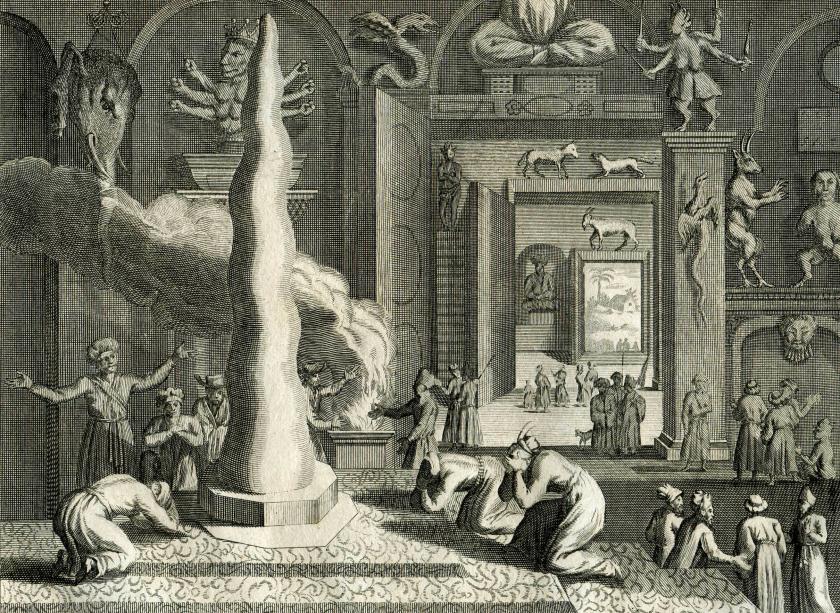Lord Siva was depicted as Ixora God or Mahadev in engravings done during late 16th century by Europeans who visited Indian subcontinent.

Theodorus de Bry (1528 – 27 March 1598) published his book Grand Voyages around 1590 CE, which has engravings of Lord Siva with 16 hands, wearing tiger skin, with half moon on his head but in blonde hair.
Ixora God has human heads worn around his neck (instead of skulls as worn by Siva), body covered with snakes and a third eye on forehead.
The usual Panchamukha (5 faced) Siva has similar weapons in 10 hands, but the extra 6 hands are unusual.
Ixora God is shown holding a wheel (possible Sudarsana Chakra, which he actually gifted to Lord Vishnu) and a metal chain, which is seen no where else.
The Trishool (Trident) is normal.
The same image was later reproduced by Bernard Picart (11 June 1673 – 8 May 1733), who was a french engraver in his collection.
Ixora God or Ishvara as Siva Lingam

In above picture, Ixora God or Lord Siva is depicted as Lingam.
This is a stone lingam but made to appear like fire.
Siva and Linga Puranas states that first Siva Lingam originally emerged as a pillar of fire with no possible begining or end.
There is also a Havan Kund next to lingam.

In some engravings, Ixora God is shown as a four faced bearded man who could heal the sick.
In above picture, a sick person is brought to Ixora God to pray for quick recovery.
There might be a possible confusion in between Siva and Brahma (4 faced), but again, Siva is the healer, while Brahma is the creator.
Brahma as Brama is shown in a EGG shape (Brahmanda)
 The creator god Brahma is depicted in engravings as Brama, with one head but inside a egg shape.
The creator god Brahma is depicted in engravings as Brama, with one head but inside a egg shape.
Brahmanda (Brahma’s Anda = Creator’s Egg) is the shape of the entire creation, which is in shape of a egg.
Brahmanda Purana confirms this statement.
Theodorus De Bry created a large number of engraved illustrations for his books. Most of his books were based on first-hand observations by explorers.
It is possible that the europeans who travelled to Indian subcontinent during 16th century might have described or taken down notes of what they saw and De Bry engraved them.
He was born in Belgium but lived in Germany.
These engravings were projected as if Romans and French worshipped Siva as Ixora god, which is a HOAX !
The term Ixora is distorted version of Eeswara or Ishvara, who is none other than Siva.
About 100 years later, Bernard Picart used them in his works. Picart never left Europe, but he relied on accounts by those who had and had access to a collection of Indian sculpture.
His original French edition of Cérémonies comprises ten volumes of text and engravings.
It even has marriages, child births, celebrations of festivals like Holi, cremations, Lord Vishnu depicted as Witsnou etc.
